|
There are over fifty species in the genus Hypomyces with most of them occuring in North America. They are actually parasitic
fungi that attack mushrooms and disfigure them to the point where trying to determine the host is most often impossible. In
my experience there are three species that are common in Nova Scotia and it is to these three species that I devote this
page . The three species are dealt with below;
- Hypomyces chrysospermus which attacks members of the family Boletaceae eventually turning the mushroom
in to a brown mush.
- Hypomyces hyalinus which attacks members of the Amanitaceae family turning them yellow or white
and disfigureing them so that they look like "club" mushrooms.
- Hypomyces lactifluorum,which turns usually white mushrooms from the genera Russula
and Lactarius in to an orange or reddish lobster mushroom.
Hypomyces chrysospermus,or as it is commonly called the bolete mold or the golden hypomyces mold attacks only
boletes. In it's first stage it is powdery white turning golden yellow and finally in to a brown mush. Very common after summer
rains and it has ruined my patch of Boletus edulis,the King Bolete more than once.
|
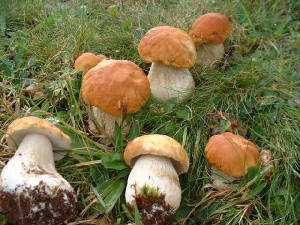
A few prize specimens of the King bolete before the bugs or Hypomyces chrysospermus got to them.
|
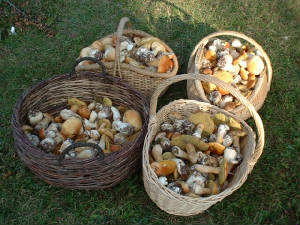
We beat the bugs and H. chrysospermus,unfortunately that's not always the case.
|
One of the King boletes that H.chrysospermus succesfully attacked(and there were others). Seen in photograph is the yellow,or
golden stage of decay.
|
|
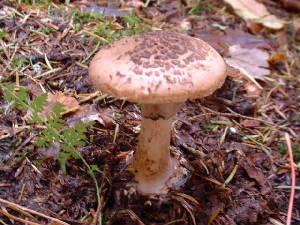
The Blusher, Amanita rubescens.
|
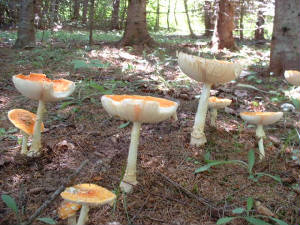
Yellow Orange Fly Agaric, Amanita muscaria var formosa.
|
Hypomyces hyalinus attacks only species of the family Amanitaceae particularly Amanita rubescens.I
have also seen it on Amanita muscaria var formosa. A.muscaria var formosa is by far the most common Amanita
that I have seen in Nova Scotia so it's not really surprising to see it attacked so often.
The photographs above show A.rubescens and A.muscaria var formosa in their usual handsome form.
The photographs below show a group of what was probably A.rubescens after they had been attacked by H.hyalinus.
|
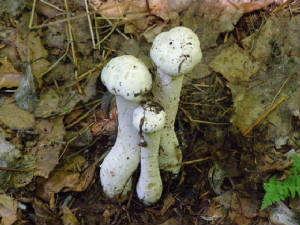
Amanita rubescens attacked by Hypomyces hyalinus.
|
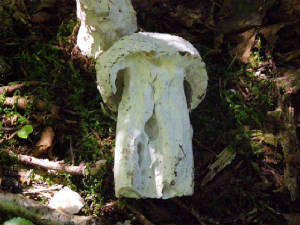
Amanita rubescens attacked by Hypomyces hyalinus shown cut longitudinally.
|
| Russula brevipes,Short stalked white russula. |
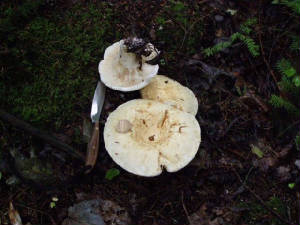
|
| Russula brevipes,Short stalked white russula. |
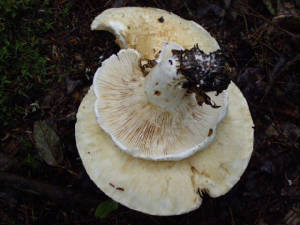
|
Easily the most recognisable of the three Hypomyces species dealt with here is H.lactifluorum or as it
is commonly known the Lobster mushroom. It turns usually white species of mushrooms from the genera Russula
or Lactarius in to an orange or reddish colour and in the process disfigures the mushroom, especially the gills. H.lactifluorum
commonly attacks Russula brevipes,the short stalked russula and also Lactarius piperatus,the peppery milky. Both of these
mushrooms are white in colour before they are attacked and are very similar in appearance,it is very possible that you could
mistake one from the other. It is also possible that H.lactifluorum could attack mushrooms other than the two given here
as examples. All species from the genus Lactarius "bleed" a milky fluid (latex) when the gills are cut with a knife.
It is the colour of the latex that is an identifying characteristic when attempting to identify to species. In some species
the latex will actually change colour after a "short time",this is also a handy tool when identifying to species.
Species from the genus Russula, on the other hand, do not bleed.
| Lactarius piperatus,Peppery milky. |
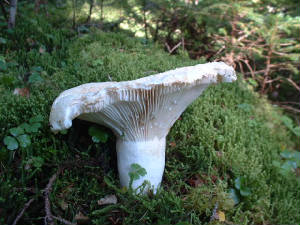
|
| Lactarius piperatus, Peppery milky. |
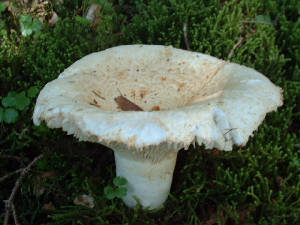
|
If you should find H.lactifluorum and you have a hand lense with you,10x is adequate,take a close look at the flesh and
you will see raised "pimples" or perithecium. Pictured below are examples of the lobster mushroom.
Hypomyces lactifluorum, Lobster mushroom.
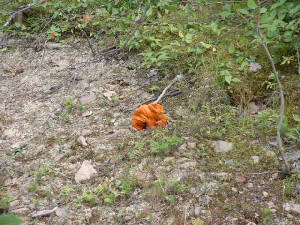
|
Hypomyces lactifluorum, Lobster mushroom.
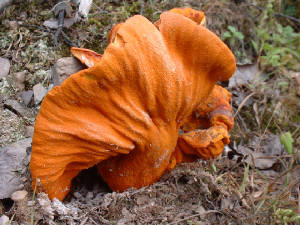
|
Hypomyces lactifluorum, Lobster mushroom.
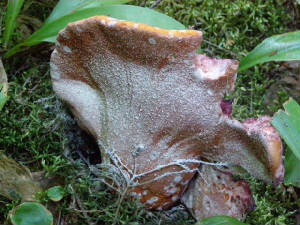
|
|




